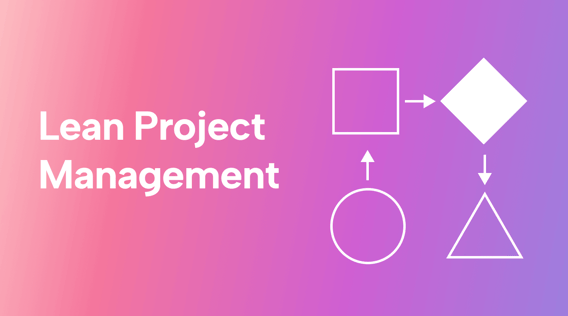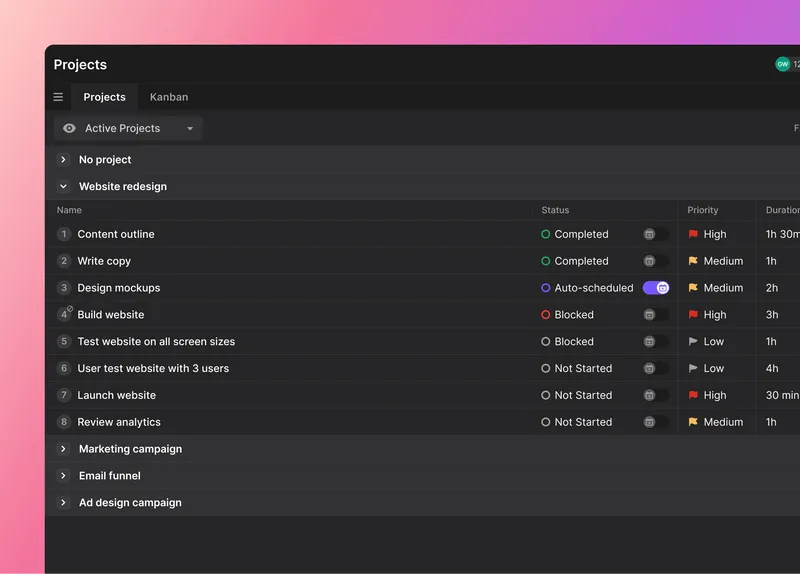Are you tired of projects that never seem to end and cost more than anticipated? Are you constantly battling scope creep, delays, and budget overruns?
It's time to fight back with Lean project management.
Just like a boxer, Lean project management is all about being quick on your feet, with an agile approach and powerful execution. It's a methodology that helps you streamline project delivery, optimize resources, and minimize waste.
In this post, we will go over the following:
- What is Lean project management?
- Uses of Lean PM
- The five core principles of Lean
- Explore the most effective tools for applying Lean practices
- And how Motion takes Lean to the next level.
So, put on your boxing gloves and get ready to learn how to float like a butterfly and sting like a bee with Lean project management.
What is Lean project management?
Lean project management is a methodology that focuses on streamlining project delivery, optimizing resources, and minimizing waste. It aims to turn your team into a lean, mean fighting machine by cutting out excess fat and trimming down your process to be as efficient and rewarding as possible.
The basic concept of Lean project management is to add value and eliminate waste. In other words, you want to focus on the activities that directly contribute to the project's success while minimizing non-value-added activities. This approach helps you deliver projects faster, with higher quality, and at a lower cost.
The Lean project management methodology is not a one-size-fits-all solution, but you can adapt it to fit the specific needs and constraints of most projects. The key is to follow a mindset of continuous improvement and to always look for ways to optimize your processes.
In the next section, we'll explore the history of Lean project management and how it evolved into a project management method.
The history of Lean
The Lean methodology has its roots in the traditional manufacturing industry, specifically, the Toyota Production System (TPS) developed by Toyota in the 1950s. They designed the TPS to improve manufacturing efficiency by minimizing waste and maximizing value.
The term “Lean” comes from James P. Womack and his colleagues in the book, “The Machine That Changed the World,” which analyzed the success of the Toyota Production System and its Lean approach to the manufacturing industry.
Since then, Lean principles have gone beyond the manufacturing industry and into other fields such as healthcare, construction, and software development. Its focus on continuous flow improvement, waste reduction, and value creation has made it a popular approach for businesses looking to increase efficiency.
Lean project management
Lean project management has evolved from the Lean manufacturing methodology and is now applied to a wide range of industries, from software development to construction.
Lean project management applies the principles of Lean to the project management process. It focuses on delivering projects faster, with higher quality, and at a lower cost by minimizing waste and optimizing resources.
Lean project management aims to create a culture of continuous improvement and eliminate types of waste from the project lifecycle. This approach helps teams to work smarter, not harder, by prioritizing work that has the most impact on the project's success.
Let’s explore the five core principles of Lean project management and how you can apply them to your projects.
What are the principles of Lean project management?
In order to apply Lean principles to your project management, it's essential to understand the five core principles of Lean project management.
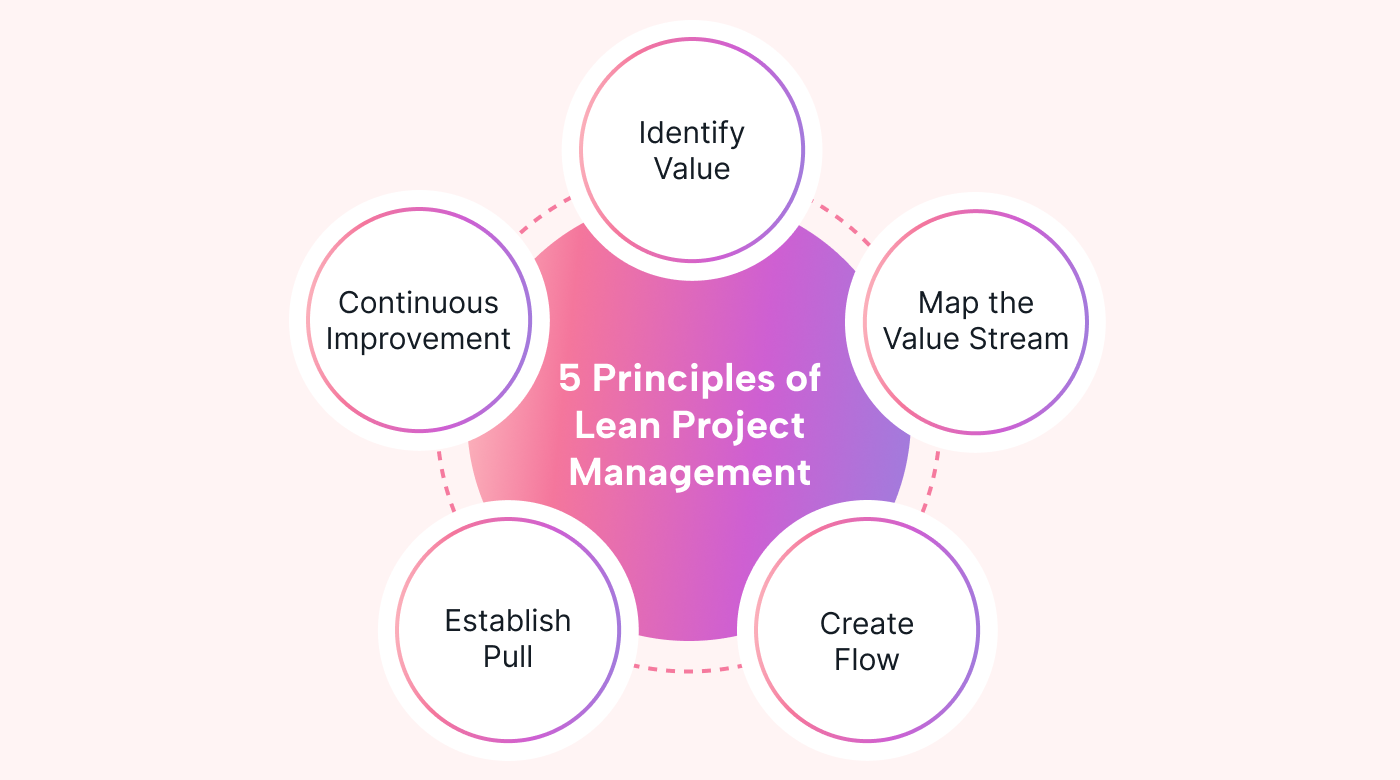 |
Below is a quick summary of the five principles before we take a closer look at each:
- Specify value: defining what your customer considers valuable to focus on delivering that value.
- Map the value stream and eliminate waste: to streamline the project lifecycle process.
- Make value flow at the customer's demand: throughout the project lifecycle.
- Establish pull: to drive the project and its resources rather than pushing work through based on assumptions.
- Embrace continuous improvement in pursuit of perfection: to increase efficiency, reduce costs, and improve quality.
1. Specify value
The first step is to understand what your customer considers valuable and focus your efforts on delivering that value.
Value can take many forms, such as meeting specific timelines, fulfilling certain requirements, or exceeding customer expectations.
It's essential to have a clear understanding of what the customer considers valuable so that the project team can focus on delivering that value rather than wasting time on activities that don't contribute to the end goal.
Project managers should work closely with the customer to specify value to identify their needs and requirements. This process involves asking questions, listening carefully to feedback, and adjusting the project plan as needed.
2. Map the value stream & eliminate waste
Once you've specified value, it's time to map all the steps and processes necessary to complete the project. To do this, use a cycle, timeline, or other visual tools (such as a Kanban board or Gantt chart) to create a clear and comprehensive view of the project.
By mapping the value stream, you can identify all the steps required to deliver the value specified by the customer. This includes determining which steps add value and which do not. Once you've identified these steps, you can work to eliminate any that don't contribute to the end goal.
When mapping the value, it helps to involve the team members from all departments, so you can streamline the project and increase accountability. This encourages each team member to take ownership of their specific role and contribute to the overall success of the project, resulting in a more efficient and effective workflow.
3. Let value flow
Once you have removed waste from your process, the next step is to ensure that value flows smoothly and efficiently to the customer. This means eliminating or minimizing bottlenecks and unnecessary dependencies that could slow the workflow.
It is important to involve all stakeholders to identify potential obstacles and develop solutions. By working together, you can streamline the process and ensure that the value flows seamlessly to the customer's demand.
This increases efficiency and productivity and improves customer satisfaction by delivering value in a timely and effective manner.
4. Establish pull
Once the continuous flow has been optimized, it's time to ensure that the customer and stakeholder get the expected outcome from final product as quickly as possible.
 |
This is achieved by aligning the workflow with the customer's demand and making sure that each step of the process is geared towards delivering value.
By doing so, you can improve time-to-market and respond more quickly to changes in customer needs or preferences.
It's important to remember that establishing pull requires a collaborative effort among team members and stakeholders to ensure that the final product meets the customer's expectations.
5. Embrace the continuous pursuit of perfection
Embracing the continuous pursuit of perfection means recognizing that improvement is a never-ending process.
Even after stream mapping, refining, and pulling, there will always be ways to improve. It may take several attempts to achieve the desired results, but staying committed to the process is essential.
Continuous improvement involves identifying areas of waste and finding ways to innovate and add value. Do this through tracking progress, having regular meetings, and encouraging open communication and feedback.
By embracing a continuous improvement mindset, your team can remain agile and adaptable, ready to strike like a boxer.
Examples of Lean project management
Lean project management has proven to be a successful approach in a variety of industries.
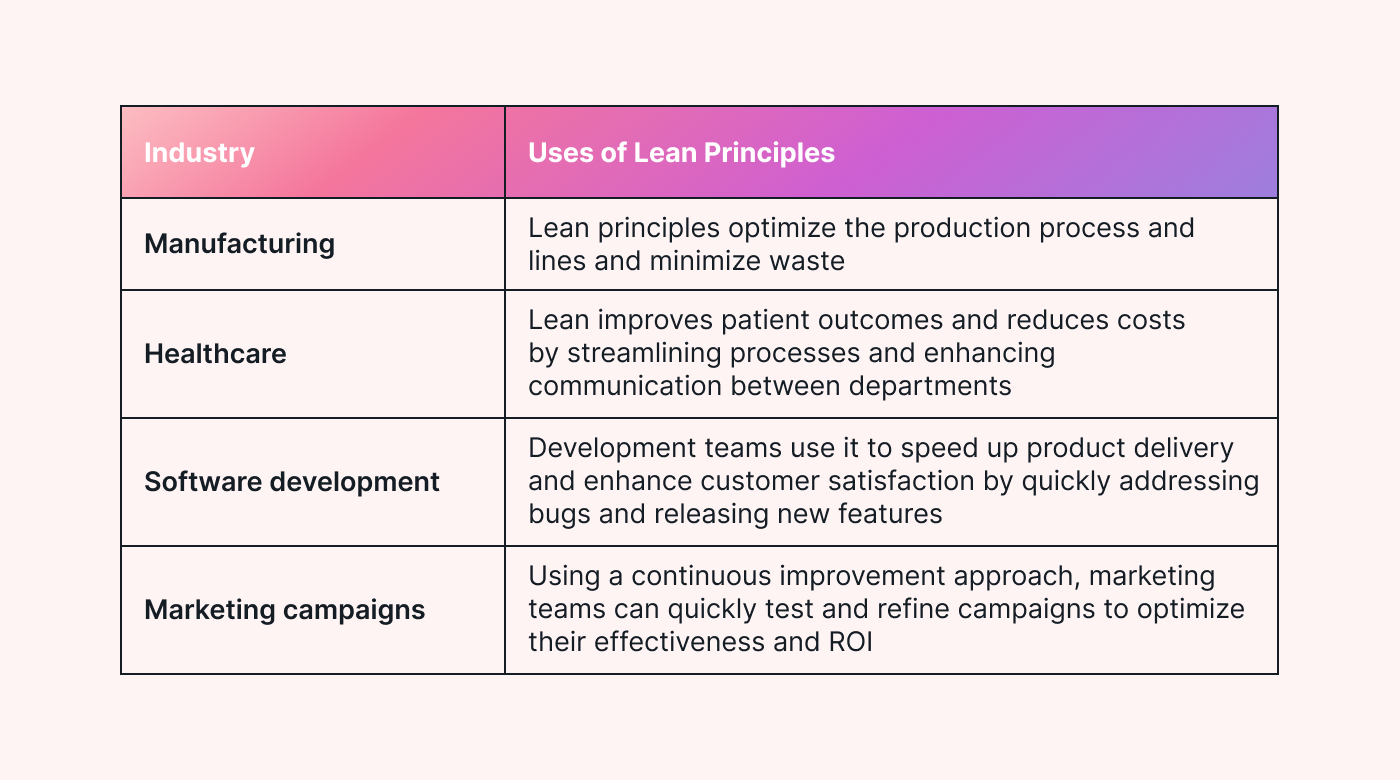 |
Above are just a few examples of how Lean project management can help businesses to achieve their goals and stay competitive in today's fast-paced business environment.
Lean project management and the PDCA cycle
A popular Lean project management technique is the PDCA cycle.
Let’s explore this technique in more detail.
Plan-Do-Check-Act (PDCA) cycle
The PDCA cycle is a problem-solving and change management approach involving the continuous cycle of planning, doing, checking, and acting.
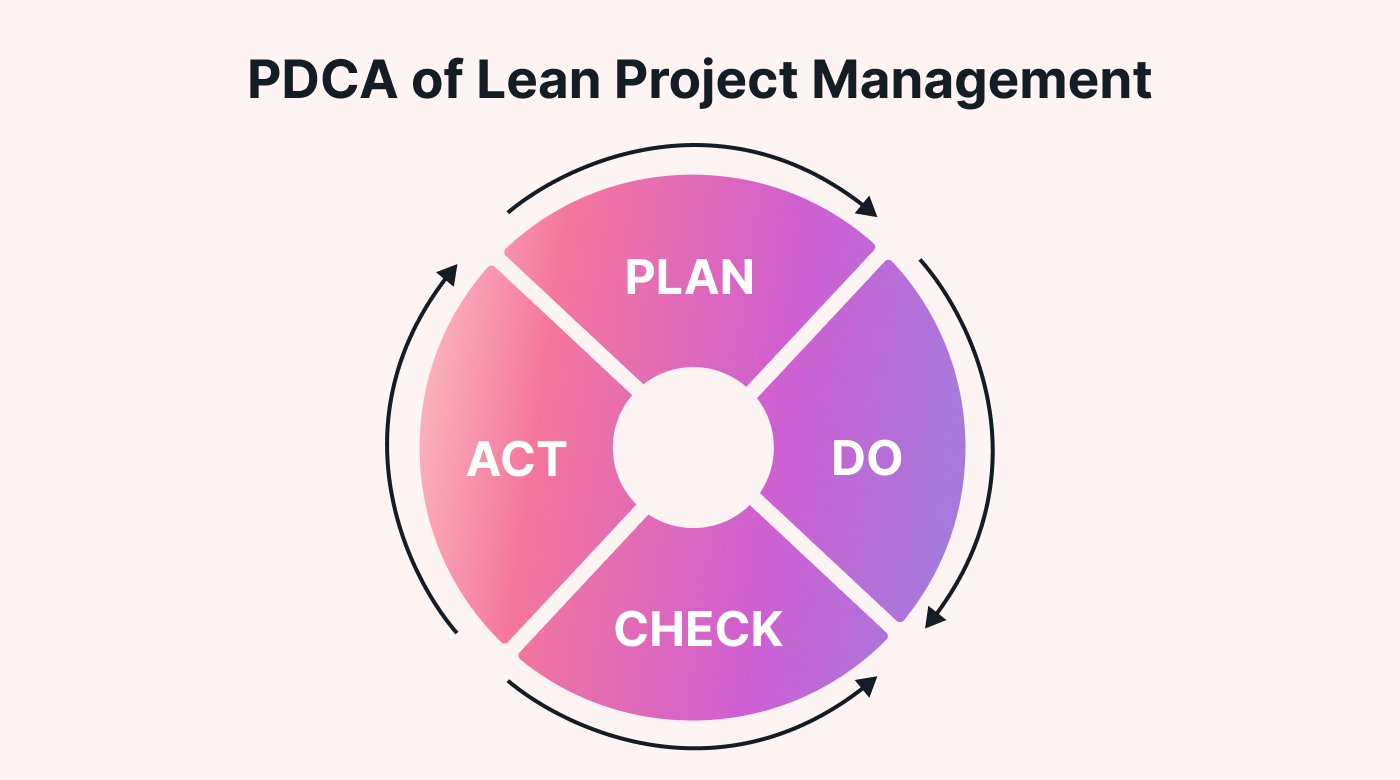 |
Breaking down the problem-solving and change management approach into four steps allows businesses to improve their workflow and make necessary adjustments continuously.
Using the PDCA cycle, businesses can implement changes on a smaller scale before making larger changes to practices and procedures. This allows for a more controlled and efficient approach to improving workflow and helps to ensure that changes are effective before they are implemented on a broader scale.
Here are the four steps of the PDCA cycle:
- Plan: This involves investigating your workflow and identifying problems that need solving. Then, you can develop a plan for how to solve the problem, including defining what data will be collected and how it will be analyzed.
- Do: In this step, you implement your plan. This may involve making changes to your workflow or implementing new procedures. Documenting everything you do during this step, including any unexpected issues or results, is essential.
- Check: After implementing your plan, you need to monitor its effectiveness. This involves collecting and analyzing data to evaluate the results. If the results meet your target, you can move on to the next step. If not, you may need to revise your plan.
- Act: In the final step, apply the revised plan and assess your learning. If the revised plan is effective, it can be standardized and integrated into your workflow. If not, you can repeat the PDCA cycle to continue improving your processes.
Using the PDCA cycle, you can continuously improve your workflow and make small, iterative changes to achieve greater efficiency.
Motion makes Lean project management easier
If you're looking for a tool to help you implement Lean project management, Motion is just what you need.
This software can streamline your workflow and improve communication and collaboration between team members, helping you to achieve your goals more efficiently.
4 ways Motion helps make your team leaner:
- Motion can help teams be more productive by automating many repetitive tasks involved in project management. This can free up time for team members to focus on more strategic activities and deliver better results.
- By using Motion to manage their projects, teams can have greater visibility into the progress of their work and identify potential bottlenecks more quickly. This can help them to take corrective action sooner and keep projects on track.
- Motion can improve communication between team members by providing a central platform for collaboration. This can reduce the likelihood of misunderstandings and ensure that everyone is working towards the same goals.
- Using Motion can help to reduce the risk of errors and omissions by automating many of the processes involved. This can improve project data's accuracy and reliability, leading to better decision-making and improved outcomes.
Overall, Motion can make Lean project management easier and more effective by providing teams with the tools to collaborate, manage tasks, and track progress in a centralized platform.
Turn your team into a Lean PM machine
Implementing Lean project management principles and tools can help businesses achieve their goals and stay competitive in today's fast-paced business environment.
To start implementing Lean project management in your organization, consider conducting a thorough analysis of your workflow, identifying areas for improvement, and implementing changes using the PDCA cycle.
Additionally, consider using software tools like Motion to streamline project management and improve team collaboration.
By taking these steps, you can turn your team into an ever-evolving Lean machine that consistently delivers high-quality products and services.
Take action today and start implementing Lean project management in your organization.
Grab your free trial of Motion here.

